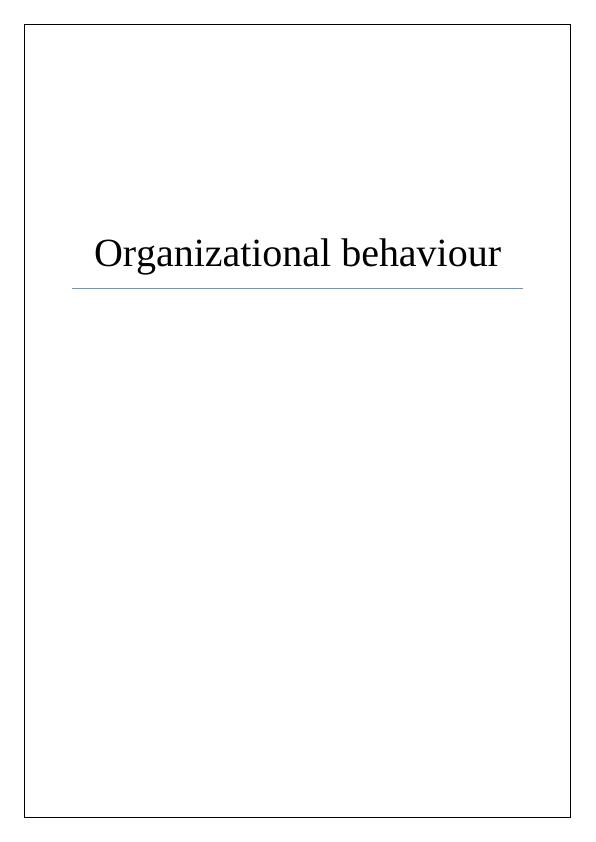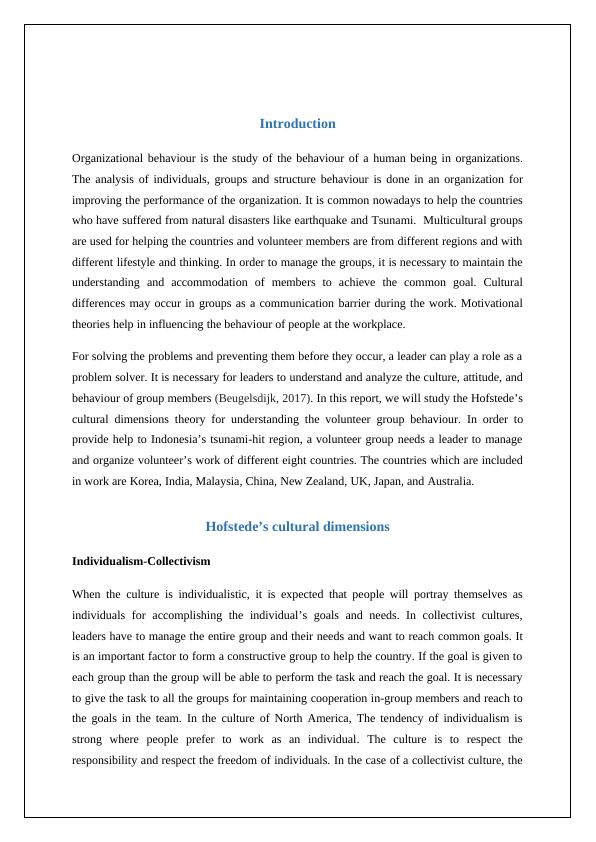Organizational behaviour.
Added on 2022-10-12
15 Pages5359 Words7 Views
Organizational behaviour

Contents
Introduction................................................................................................................................3
Hofstede’s cultural dimensions..................................................................................................3
Group Dynamics........................................................................................................................8
Culture........................................................................................................................................8
Motivation to team members.....................................................................................................9
Communication........................................................................................................................10
Conclusion and Recommendation............................................................................................11
Reference..................................................................................................................................12
Introduction................................................................................................................................3
Hofstede’s cultural dimensions..................................................................................................3
Group Dynamics........................................................................................................................8
Culture........................................................................................................................................8
Motivation to team members.....................................................................................................9
Communication........................................................................................................................10
Conclusion and Recommendation............................................................................................11
Reference..................................................................................................................................12

Introduction
Organizational behaviour is the study of the behaviour of a human being in organizations.
The analysis of individuals, groups and structure behaviour is done in an organization for
improving the performance of the organization. It is common nowadays to help the countries
who have suffered from natural disasters like earthquake and Tsunami. Multicultural groups
are used for helping the countries and volunteer members are from different regions and with
different lifestyle and thinking. In order to manage the groups, it is necessary to maintain the
understanding and accommodation of members to achieve the common goal. Cultural
differences may occur in groups as a communication barrier during the work. Motivational
theories help in influencing the behaviour of people at the workplace.
For solving the problems and preventing them before they occur, a leader can play a role as a
problem solver. It is necessary for leaders to understand and analyze the culture, attitude, and
behaviour of group members (Beugelsdijk, 2017). In this report, we will study the Hofstede’s
cultural dimensions theory for understanding the volunteer group behaviour. In order to
provide help to Indonesia’s tsunami-hit region, a volunteer group needs a leader to manage
and organize volunteer’s work of different eight countries. The countries which are included
in work are Korea, India, Malaysia, China, New Zealand, UK, Japan, and Australia.
Hofstede’s cultural dimensions
Individualism-Collectivism
When the culture is individualistic, it is expected that people will portray themselves as
individuals for accomplishing the individual’s goals and needs. In collectivist cultures,
leaders have to manage the entire group and their needs and want to reach common goals. It
is an important factor to form a constructive group to help the country. If the goal is given to
each group than the group will be able to perform the task and reach the goal. It is necessary
to give the task to all the groups for maintaining cooperation in-group members and reach to
the goals in the team. In the culture of North America, The tendency of individualism is
strong where people prefer to work as an individual. The culture is to respect the
responsibility and respect the freedom of individuals. In the case of a collectivist culture, the
Organizational behaviour is the study of the behaviour of a human being in organizations.
The analysis of individuals, groups and structure behaviour is done in an organization for
improving the performance of the organization. It is common nowadays to help the countries
who have suffered from natural disasters like earthquake and Tsunami. Multicultural groups
are used for helping the countries and volunteer members are from different regions and with
different lifestyle and thinking. In order to manage the groups, it is necessary to maintain the
understanding and accommodation of members to achieve the common goal. Cultural
differences may occur in groups as a communication barrier during the work. Motivational
theories help in influencing the behaviour of people at the workplace.
For solving the problems and preventing them before they occur, a leader can play a role as a
problem solver. It is necessary for leaders to understand and analyze the culture, attitude, and
behaviour of group members (Beugelsdijk, 2017). In this report, we will study the Hofstede’s
cultural dimensions theory for understanding the volunteer group behaviour. In order to
provide help to Indonesia’s tsunami-hit region, a volunteer group needs a leader to manage
and organize volunteer’s work of different eight countries. The countries which are included
in work are Korea, India, Malaysia, China, New Zealand, UK, Japan, and Australia.
Hofstede’s cultural dimensions
Individualism-Collectivism
When the culture is individualistic, it is expected that people will portray themselves as
individuals for accomplishing the individual’s goals and needs. In collectivist cultures,
leaders have to manage the entire group and their needs and want to reach common goals. It
is an important factor to form a constructive group to help the country. If the goal is given to
each group than the group will be able to perform the task and reach the goal. It is necessary
to give the task to all the groups for maintaining cooperation in-group members and reach to
the goals in the team. In the culture of North America, The tendency of individualism is
strong where people prefer to work as an individual. The culture is to respect the
responsibility and respect the freedom of individuals. In the case of a collectivist culture, the

emphasize is to work in a group. People who can work in a group are from Japan and Korea
as they represent the culture of collectivist (Croucher, et al., 2015). In some similar culture
also there are cultural differences. When we talk about the strong collectivist culture, the
Arab is the strongest in all. According to Hofstede's theory, it is necessary to consider the
culture of individualism and collectivism. When we compare the culture of different
countries that are helping Indonesia, according to Hofstede’s theory, the countries that have
strong individualism are the UK, Australia, and New Zealand and the people from Japan,
India, are in middle and can adopt collectivism as well as individualism. But the countries
like Korea and China are classified as strong collectivism. Japan and India are in middle
culture where Korea has an almost similar culture like Japan. There is a strong collectivist
culture in other countries than the UK, Australia and New Zealand (Favaretto, et al., 2016).
People who are considered as a strong individualism, they can view the relationship between
the team members and Leader as can make a mutual benefit for each other. The contracts
between the team leaders and members are made on the basis of rules and technology which
can be adapted to take mutual benefits. People from different cultures need independence in
the group while making the decisions but managers have to emphasize the diversity and
leadership within a group (Osabiya, 2015). For setting the goal and motivation for team
members it is necessary to emphasize the challenges and freedom to team members. For the
effective organizational culture during the work, it is necessary to construct effective
thoughts and communicate with team members effectively. People from different culture
have a different state of mind (Holden, 2002). In collectivism, it is necessary to identify
strong collectivism to create a social network with the people who belong to individualism
(Nistor, et al., 2014). It is necessary for managers to maintain unity and focus on forming a
team effectively by considering the work and their cultures. It is necessary for leaders and
team members to form an effective team and build a good relationship with each other. The
countries which have strong collectivism must be given a coordinative team and culture
where they can work effectively.
Masculinity vs. Femininity (MAS)
In Hofstede’ theory, masculinity vs. Femininity includes the role of men and women which
are distributed. In MAS, the social roles are divided as the tendency of a culture. In order to
achieve the goals and assertiveness, it is necessary to follow the culture. In Japan, the
masculine culture is considered and in Thailand, feminine culture is more preferred than
as they represent the culture of collectivist (Croucher, et al., 2015). In some similar culture
also there are cultural differences. When we talk about the strong collectivist culture, the
Arab is the strongest in all. According to Hofstede's theory, it is necessary to consider the
culture of individualism and collectivism. When we compare the culture of different
countries that are helping Indonesia, according to Hofstede’s theory, the countries that have
strong individualism are the UK, Australia, and New Zealand and the people from Japan,
India, are in middle and can adopt collectivism as well as individualism. But the countries
like Korea and China are classified as strong collectivism. Japan and India are in middle
culture where Korea has an almost similar culture like Japan. There is a strong collectivist
culture in other countries than the UK, Australia and New Zealand (Favaretto, et al., 2016).
People who are considered as a strong individualism, they can view the relationship between
the team members and Leader as can make a mutual benefit for each other. The contracts
between the team leaders and members are made on the basis of rules and technology which
can be adapted to take mutual benefits. People from different cultures need independence in
the group while making the decisions but managers have to emphasize the diversity and
leadership within a group (Osabiya, 2015). For setting the goal and motivation for team
members it is necessary to emphasize the challenges and freedom to team members. For the
effective organizational culture during the work, it is necessary to construct effective
thoughts and communicate with team members effectively. People from different culture
have a different state of mind (Holden, 2002). In collectivism, it is necessary to identify
strong collectivism to create a social network with the people who belong to individualism
(Nistor, et al., 2014). It is necessary for managers to maintain unity and focus on forming a
team effectively by considering the work and their cultures. It is necessary for leaders and
team members to form an effective team and build a good relationship with each other. The
countries which have strong collectivism must be given a coordinative team and culture
where they can work effectively.
Masculinity vs. Femininity (MAS)
In Hofstede’ theory, masculinity vs. Femininity includes the role of men and women which
are distributed. In MAS, the social roles are divided as the tendency of a culture. In order to
achieve the goals and assertiveness, it is necessary to follow the culture. In Japan, the
masculine culture is considered and in Thailand, feminine culture is more preferred than

End of preview
Want to access all the pages? Upload your documents or become a member.
Related Documents
Essay on Organizational Behavior 2022lg...
|18
|5213
|18
Organizational Change Management: A Comparison between Singapore and Australialg...
|12
|2338
|186
Study Skills for Higher Educationlg...
|12
|2710
|66
Comparison of HR Policies and Practices in UK and Japanlg...
|8
|2091
|206
Study Skills for Higher Education (Doc)lg...
|7
|1269
|98
International Businesslg...
|11
|2506
|316
